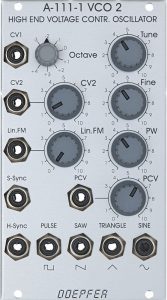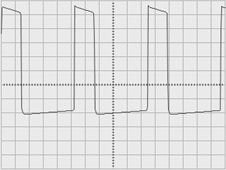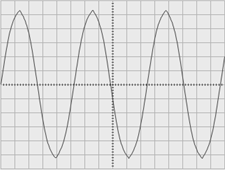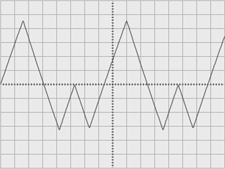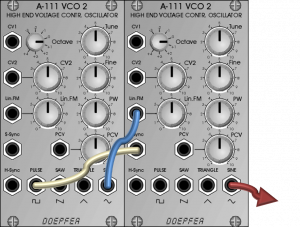The module is no longer in production.
The A-111-1 was the high-end model among Doepfer’s oscillators and is only available on the used market. The successor model with some detailed improvements is the A-111-2. Compared to the A-110-1 or A-110-2, the A-111-1 offers expanded synchronization options, an additional input for linear frequency modulation, and a more extensive frequency range (12 octaves, compared to 10 octaves on the A-110-1).
In addition, the A-111-1 has a slightly different basic sound than the A-110-1 or A-110-2; the waveforms (especially sine, triangle) are generally produced more precisely here. Incidentally, the sawtooth is (contrary to the labeling on the panel) a rising sawtooth and not a falling one like on the A-110-1. This doesn’t change the sound per se, but it is interesting with a synchronized mix with an A-110-1 sawtooth, which then sounds a little different than with two A-110-1s. Otherwise, the sine signal here is not a “mathematically exact sine”, but is obtained from the triangle core via a simple diode circuit. The successor A-111-2 has a revised circuit that produces a much more precise sine signal from the triangle.
So what does this “oscillation theory” look like on the oscilloscope?
The A-111-1 is definitely a little “cleaner” than the A-110-1, but a little less “precise” than you might have expected. Does it sound better than the A-110-1? “More noble”? More expensive? A Bösendorfer grand piano sounds different than a Steinway, but which one is better? As always, this is clearly a matter of taste and the area of application. The sonic differences between oscillators are usually significantly smaller than those between different filters.
The CEM3340 integrated circuit (from Curtis), on which the A-111-1 is based, was used in some fairly well-known synthesizers: Crumar Spirit, Moog Memorymoog, Oberheim OBXa, OBSX, OB8, Roland Jupiter-6, Roland SH-101, Roland MC-202, Roland MKS-80 (rev 4), Sequential Pro-One, Sequential Prophet-5 rev 3, Sequential Prophet-10, Sequential Prophet-600, Sequential T8, Synton Syrinx.
Unfortunately, this integrated circuit is no longer manufactured, so production of the module had to be discontinued.
User interface
Inputs:
System bus: As with the A-110, the pitch of the A-111 can be controlled via a voltage on the system bus. The system bus can be addressed with an A-185-1 or A-185-2.
As with all VCOs with CV control via the bus, you should deactivate this option if you are not using it: Otherwise, the open lines could work as “antennas” and pick up interference signals.
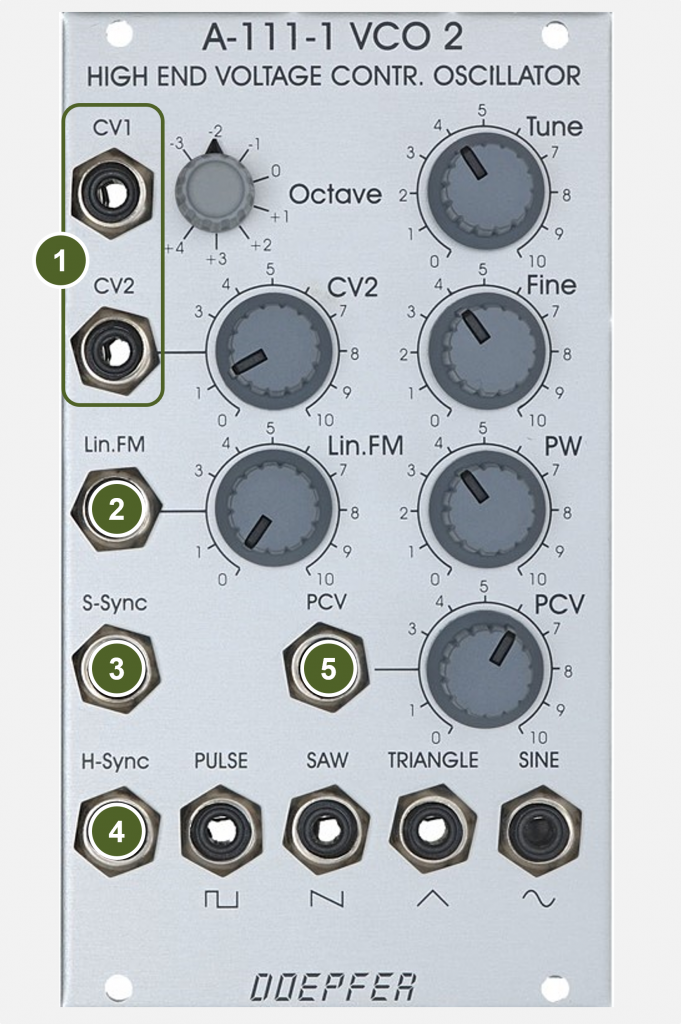
- Two control voltage inputs (CV1 and CV2) for voltages that control the frequency of the VCO, one of them with an attenuator. Control characteristic is 1 V / octave. In contrast to the A-110-1, the “CV1” input is not designed as a switching socket that would interrupt the control voltage via the system bus. Voltages from the system bus and “CV1” are added.
- Lin. FM: In contrast to exponential frequency modulation, linear FM does not give the impression that the frequency of the modulated oscillator is changing. This makes it easy to play melodies; the basic principle has been common knowledge since the DX7 synthesizers of the 80s. However, due to digitally generated sine waves with a fixed phase relationship to one another, these had a different sound character than the FM from analog VCOs.
- S-SYNC: The “Softsync” input is used to adjust the frequency of the VCO to that of a “master” VCO. In contrast to hard synchronization on the A-110 or A-111-1, there is no change in sound, the waveform of the synchronized oscillator is not “folded” or restarted in the middle.
- H-SYNC: The “Hardsync” input reacts to both rising and falling edges. This means that even more “sound bending” is possible than with the A-110, whose “Hardsync” only reacts to falling edges.
- PCV: Modulation input for the pulse width, also provided with an attenuator.
Outputs:

- A separate output each for pulse, sawtooth, triangle and sine, comparable to the A-110-1.
Controls:
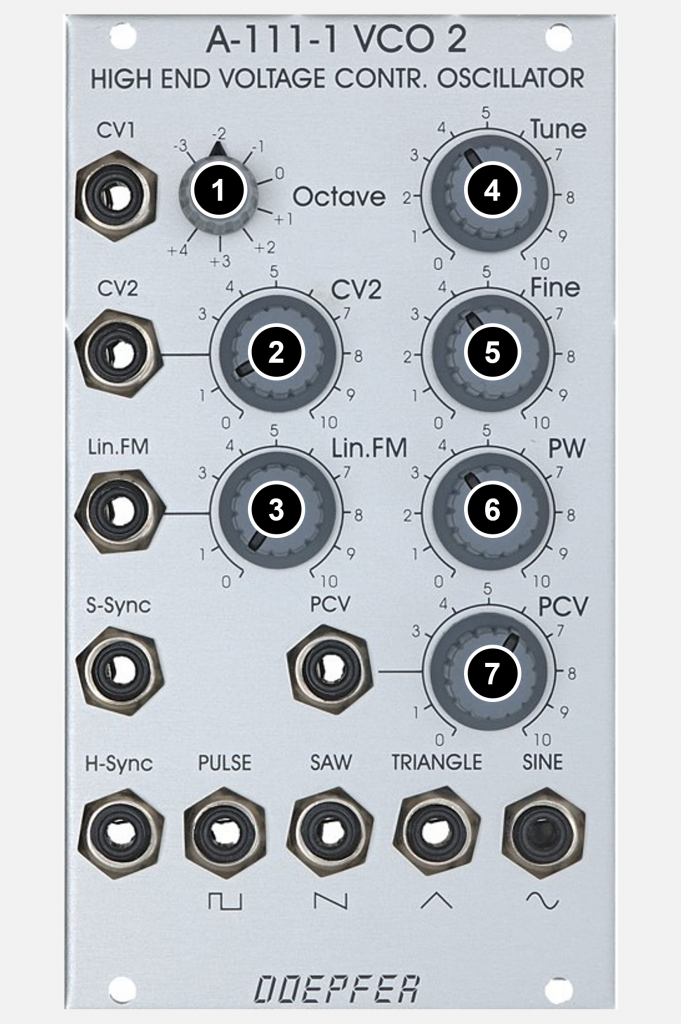
- Octave – selector switch with a range of -3 to +4 octaves. The higher switch positions (“+5” and “+6”, not labeled) can still be switched due to the grid of the selector switch, but (in contrast to the A-110) do not cause any further change in frequency.
- Controller CV2 for attenuating the control voltage at the “CV2” input.
- Controller Lin. FM for attenuating the control voltage at the “Lin. FM” input.
- Tune control for the coarse tuning of the oscillator in the range of approximately +/- 1/2 octave.
- Controller Fine for fine-tuning.
- Manual adjustment of the pulse width with the PW controller.
- Attenuator PCV for the control voltage at the “PCV” input for pulse width modulation.
Sync and linear FM are the strengths of the A-111-1
The A-111-1’s standard operating area is comparable to that of the A-110-1. However, due to the significantly higher price, it is more useful for tasks in which it can demonstrate its specific strengths: different colors during synchronization, linear frequency modulation.
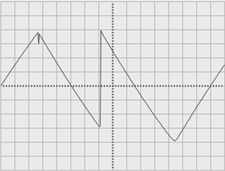
It is clear from the illustrations that one cannot speak of “better” or “worse” for the two types of synchronization: In terms of sound, the A-111-1 largely produces a triangular oscillation with a higher frequency, while the A-110-1 moves strongly in the direction of “sawtooth”, which means significantly more overtones.
Softsync in conjunction with FM
The combination of Softsync and linear FM enables phase-locked oscillations between the carrier (the modulated VCO) and the modulator – this is “almost” like what we know from digital FM synthesizers.
All tips described for the A-110-1 Standard VCO also work with the A-111-1.
Problems with other modules (early copies)
With some modules, such as the frequency dividers A-115 and A-160-1, as well as the “EXT CLC” input in the A-117, there are problems with the A-111-1: An output signal is produced from the frequency dividers for a few seconds, then it’s over. The cause lies in a technical detail (AC voltage coupling of the A-111-1 output), which has been fixed in production since around spring 2011.
With older modules you can simply connect a passive attenuator (which doesn’t have to attenuate anything) or almost any other module in between, then the problem is solved.
Alternatives
The most obvious alternative is of course the direct successor A-111-2. In addition to all the features of the A-111-1, it also offers a switch between VCO and LFO mode as well as an improved circuit for generating the sine wave from the triangle core.
The A-111 is also available in a more simply equipped version A-111-3, which still has a surprising number of the same features as the A-111-2 in just 4 HP, but you have to do without the sine wave. But even that can be expanded to another 4 HP with the Sine Converter A-184-2. A total of four of these mini VCOs are housed in the A-111-4 module, which provides a good basis for polyphonic applications, for example.
Technical specifications
| Width | 14 HP |
| Depth | 65 mm |
| Power requirements | 40 mA (+12V) / -20 mA (-12V) |
